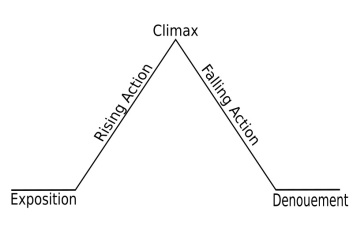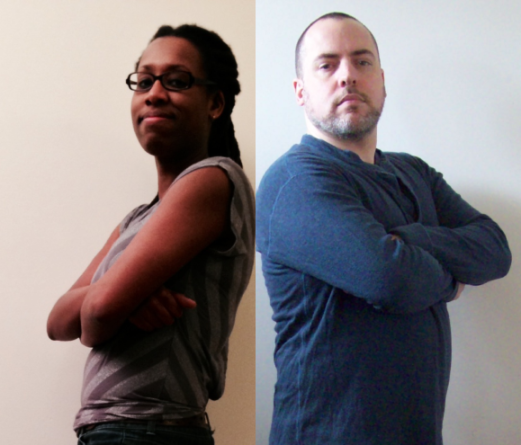Only two approaches to writing exist: Good and Bad. Write good. Debate over!
Hold on a sec. That’s not what this post is about. This post is a point-counterpoint between two WordPress bloggers arguing the merits of two distinct writing methods, pantsing (freeform writing) and plotting (writing from an outline).
Read on as right-brained, right-coast writer Eric John Baker argues in favor of pantsing (at least we hope that’s what happens… he is making it up as he goes, after all), followed by left-brained, left-coast writer Janna G. Noelle making a case for plotting, probably with all kinds of charts and graphs and stuff.
No matter how ugly and violent it gets, they promise to return you home in time for tea and biscuits!
Plotting. Pantsing. Marching. Dancing.
I’m not much of a dancer. Stepping this way and that, being graceful, weaving a pattern not immediately apparent. Can’t do it.
Walking a straight line is easier. But walking only brings me to a predetermined destination, whereas dancing can send me places far more mysterious and wonderful: Joy. Surrender. The coat closet for a snog with my dance partner (come on, all that eye contact and bodies touching… it’s nature). If only I knew the moves.
Writing is like dancing in that way. Plotter or pantser, I’m sure you’ll agree: You have to understand composition before you can write well. Until you reach that level, outlining is probably necessary. Once you’ve mastered mechanics, though, maybe not so much.
Outlining seems smart and efficient; it helps you keep track of settings, characters, and events. You know exactly where you are, eyes straight ahead, sight set on your ending.
You know what else is efficient? A pair of handcuffs. And what would we do without lines painted on the road, telling us where we can and cannot drive the car? I’d say outlines are the law enforcement of the writing world.
I used to outline my fiction, scene by scene, and I never crossed the double-yellow lines. Sure the outcome was boring and predictable but, um… I stayed true to my outline! I got to type “The End” exactly when I planned as well.
You see, once the outline was in place, my creative brain shut down. It was all about mechanics after that. The regions of my mind that encourage me to poke a dead jellyfish with a stick or to intentionally alight at the wrong bus stop or to ask, “I wonder where that road goes?” had gone dark. Any reader could guess where my stories were going, because I was telegraphing the conclusion.
Then, one day, I came across the term “blank-pager” in a writing book, though most writers call it “pantsing.” Inspired, I took a (boring and predictable) short story of mine and rewrote it, reusing only its concept and main character. I ended up with a 70,000-word novel, and it was the most fun I ever had writing. I bet any reader would say, “I didn’t see that coming,” at least a dozen times. How could they? I didn’t see it coming either. I spilled seeds as I went, and by the end, I had grown a garden of twists, hidden identities, and red herrings. Fact: my conscious mind could not have generated such ideas in advance. I know, because I had already written the same story with an outline and it failed.
I don’t actually like the word “pantser.” It sounds like a person no one wants to sit next to on the train. For my own reasons, I prefer “phone ringer,” but today I’ll stick with the more popular term because it rhymes with “dancer,” and that was seed enough to grow this argument, sans outline.
Keep Your Story In Line With An Outline
I’ve heard just about every explanation for why pantsers don’t outline their stories:
- It hinders creativity
- Knowing how a story’s going to end ruins the fun of actually writing it
- Plotters are rigid, unimaginative, their work is soulless, and they have cooties
- Creativity is a transcendent process wherein a story’s true essence only emerges when permitted to spring forth unfettered in ecstasy of inspiration, like Athena from the head of Zeus.
Or at least the first 30,000 words of true essence.
Yeah, I said it.
30,000 seems to be the magic number where many pantsers’ journeys of discovery comes up short, and unsurprisingly, they realize they’ve run out of plot.
This is unsurprising because of the nature of that which pantsers are trying to freestyle. A story isn’t an organic, right-brained, boundless entity; it’s contrived, structured, and logical. No matter how simultaneously beautiful.

Of course there was going to be a graph. (Source: http://en.wikipedia.org/wiki/File:Freytags_pyramid.svg)
Nothing that occurs in a story is just ‘coz. Everything needs to fit together in a causal chain of events that points toward an inevitable (though not necessarily predictable) ending.
If the middle of a story is saggy, it’s because it wasn’t set up well enough in Act One.
If a story’s ending is weak, it’s not a problem with the last chapter, it’s a problem on page 127.
In no other endeavour would someone leave the creation of a highly structured entity to a vague impression of how to do it coupled with chance.
If you were building a house, or a business, or a garden, you’d be all too willing to draw up a blueprint, a business plan, or a list of what actually grows in your region lest you plant bananas in the Northwest Territories.
If Eric decided to drive to Vancouver, BC to have this debate with me in person, he wouldn’t just head north in the general direction of Canada (at least I hope he wouldn’t, especially since Vancouver is northwest of New Jersey!)
Rather, he’d want much more detail of where the road ahead actually leads: some timely hints from the British GPS lady, plus a supplementary map of some navigable scale showing every major junction along the way.
Because an outline is map in the truest sense of the word: a representation of everything between here and there to help you not get lost in your own plot.
It’s not a set itinerary you’re beholden to follow. It’s not a prison sentence. You can take your story in a different direction any time you want.
You probably will, for when have you ever had something go 100% according to plan? Even President Eisenhower recognized this:
In preparing for battle I have always found that plans are useless, but planning is indispensable.
An outline will keep you moving in right direction, providing a reference if you wander too far off the beaten path. It’ll also likely save you a few drafts of backfill and the risk of growing sick of your novel before it’s completed.
And in this way, rather than hinder a writer’s creativity, plotting actually sets it free to explore and discover the full range of possibilities within the story you’re actually trying to tell.
~
There you have it, writers. The battle lines have been drawn (most likely by a plotter; they’re big on setting parameters up front). So where do you stand in this debate? Squarely inside the plotters’ outline? Over there somewhere with that bunch of pantsers gathered sorta together but sorta not because they’re free spirits, you know?
Somewhere in between?
And more importantly: which of us do you think will be the dirtier fighter if this degenerates into a back-alley brawl? All bets are on!
A/N: This debate is cross-posted on Eric’s blog. Go check him out; he’s a cool dude, for a pantser 😛


Pingback: Two Writers Debate: Pantsing vs. Plotting | ericjohnbaker
Who is that handsome guy in that picture? You never told me you hung out with movie stars.
LikeLike
I do hang out with movie stars. That guy in the picture is the dude who’s supposed to fetch all of our coffee.
LikeLike
Doesn’t look like you’re working him hard enough.
LikeLike
Wow – some of those big punches nearly came out of my computer screen to swipe me!
Sorry, Janna. I’m with Eric on this debate – I’m a definite pantser! 😉 (I’m ducking my head now)
I’ve always been a pantser and I just can’t get out of the habit. A friend of mine recently came up with an idea to help another friend who has been very ill (she has a brain tumour). He suggested the three of us sit down and work on a novel together to keep her busy. Good idea, I thought – until we started getting into it. I’m saying ‘lets just write’ and my friend is saying, ‘No – we have to plot it out’. Meanwhile, my poor friend with the brain tumour is saying, ‘this isn’t as much fun as you said it would be.’
So now we’re plotting and I’m getting confused because I know I’ll never stick to the plot (my stories have a mind of their own and just end up writing themselves). Anyway, I’ll let you know how we go 😉
I loved the debate 😀
LikeLike
I think Janna is a great writer and an even better thinker, but if we collaborated on a story, there would be busted lips and bloody noses before we got halfway through chapter one!
LikeLike
I’m hearing you, Eric! LOL 😉
LikeLike
I’m a lover, not a fighter. Well, actually….
LikeLike
Dianne, I love plotters and pantsers equally. I love writers, and think everyone has to use whatever methods work best for them. I find I don’t stick to the outlined plot either, but I find it reassuring to have the outline – to know that, if all else fails, I have an ending I can shoot for – and its that sense of reassurance that emboldens me to go off script.
I hope that you and your two co-writers are able to settle on a method that works for everyone. Co-authoring a novel sounds like a wonderful way to help your friend through her recovery. 🙂
LikeLike
I agree with you both! My instinct and practice is to just tear ahead with a fuzzy idea of where I’m going. But Janna you’re so right in that this approach can falter after a while – the ‘murky middle’ as another blogger has described it. When floundering it would be nice to resort to an original game plan and re-set one’s sights before heading off again, maybe down Eric’s side roads but generally closing in on the denouement. So that’s decided then 🙂
LikeLike
I always view plotting and pantsing as two hypothetical extremes between which most writers fall – a writing spectrum, if you will. Besides, there’s more than one way to be a plotter: some might outline first and then detour (I’ve done that; heck – I’m still doing that in my WIP); others might chase their rainbow as far as it will take them and then set about charting the rest of the course. I’m glad mine and Eric’s debate has decided you on what’s what. 🙂
LikeLike
Pingback: When do you stop rewriting and revising? | ericjohnbaker